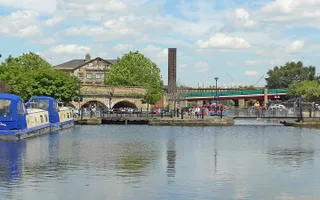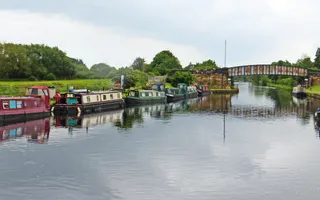Today, Sheffield Canal Basin – or Victoria Quays – is an attractive urban destination boasting canalside eateries and a hotel.
The Sheffield & Tinsley Canal history
Opened in 1819 to carry boats between the navigable River Don and a new basin in the centre of Sheffield, the Sheffield & Tinsley Canal forms the upper four miles of the Sheffield & South Yorkshire Navigation.
The canal's business was badly hit when the railway reached Sheffield in 1830, and it was taken over by the Manchester, Sheffield & Lincolnshire Railway in 1848 to become part of the River Don Navigation the following year. The Sheffield & South Yorkshire Canal Company Ltd took over the River Don in 1895, and around 1900 there were plans to enlarge the canal, and even to replace it with a ship canal. They remained as plans, and the canal was never enlarged and still has locks just large enough for Yorkshire keels, 61 feet long by 15 feet 6 inches wide.
Architecture
The enlargement work means that the waterway's architecture is principally that of a modern, functional freight navigation. However, the canal in Sheffield itself has not been enlarged and retains many original characteristics - notably the buildings around the terminal basin. The Straddle Warehouse is particularly noteworthy. It was built over the canal to make loading and unloading easier, and dominates the scene in its new life as an office complex.
The Stainforth & Keadby Canal section is also largely unaltered. The tidal lock at Keadby has been recognised by English Heritage as an ancient monument.
Art
The Sheffield and Tinsley Canal - hand cut by local people - embodies the vision, grit, ingenuity and industrious spirit of the city. Upon its completion, it transformed Sheffield from a landlocked town to an international trading hub, with a global reputation.
From the power of innovation and collaboration to the importance of community resilience and environmental stewardship, the canal's story serves as a testament to the enduring spirit of Sheffield.
When the canal opened in 1819, it was reported that crowds of 60,000 people gathered in the city centre to watch the first boats arriving from Tinsley. The flotilla was led by a boat called The Industry, which is referenced on the nameplate on The Looping Boat artwork and its design features a Tudor Rose, the Assay Mark of Sheffield.
The construction of the unique artwork draws on the inspiration provided by the historic waterway and the innovative application of steel, in a city known internationally as the home of steel.
By using the waterway, it is hoped that The Looping Boat will attract a new generation of visitors to discover the city’s canal, with its important role in Sheffield’s history.






